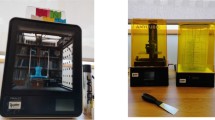Abstract
Recent studies have reported emission rates of up to 1012 ultrafine particles/min from fused filament fabrication three-dimensional printers when operated in unventilated or minimally ventilated test chambers. However, in these studies, there are no data to relate this rate to airborne concentrations in a manufacturing environment. An assessment of particle exposures of workers was conducted at a three-dimensional printing shop using multiple fused filament printers with unfilled and carbon nanotube and/or carbon nanofiber-infused polyetheletherketone filaments. The study simultaneously evaluated emissions in two environments: (1) in a field portable test chamber with one three-dimensional printer and (2) in the manufacturing area with multiple printers in use. Emission rates were calculated for a variety of filaments and ranged from 1.21 to 33.5 × 1011 particles/min, with geometric mean diameters ranging from 11.4 to 33.3 nm. The emission rates estimated by a scanning mobility particle sizer were much lower than from the fast mobility particle sizer due to differences in the lower size resolution. Samples collected in the chamber and manufacturing area by thermophoretic sampling included free (no polymer) carbon nanotubes and nanofibers and their bundles. The company reportedly never handled free carbon nanotubes or nanofibers, and prior research has indicated that the release of free nanomaterials through three-dimensional printing or mechanical action is highly unlikely. This presents the possibility that these materials are being released from the matrix during use or that these materials were brought into the facility through the supply chain, or by other means.









Similar content being viewed by others
References
Afshar-Mohajer N, Wu C-Y, Ladun T, Rajon DA, Huang Y (2015) Characterization of particulate matters and total VOC emissions from a binder jetting 3D printer. Build Environ 93:293–301
Azimi P, Zhao D, Pouzet C, Crain NE, Stephens B (2016) Emissions of ultrafine particles and volatile organic compounds from commercially available desktop three-dimensional printers with multiple filaments. Environ Sci Technol 50:1260–1268
Gu J, Wensing M, Uhde E, Salthammer T (2019) Characterization of particulate and gaseous pollutants emitted during operation of a desktop 3D printer. Environ Int 123:476–485
Huang G, Park JH, Cena LG, Shelton BL, Peters TM (2012) Evaluation of airborne particle emissions from commercial products containing carbon nanotubes. J Nanopart Res 14:1231
Kang J et al (2017) Generation and characterization of aerosols released from sanding composite nanomaterials containing carbon nanotubes. NanoImpact 5:41–50
Kim Y, Yoon C, Ham S, Park J, Kim S, Kwon O, Tsai P-J (2015) Emissions of nanoparticles and gaseous material from 3D printer operation. Environ Sci Technol 49:12044–12053
Klein RC, King C, Kosior A (2009) Laboratory air quality and room ventilation rates. J Chem Health Saf 16:36–42
Kulkarni P, Baron PA, Willeke K (eds) (2011) Aerosol measurement: principles, techniques, and applications, 3rd edn. Wiley, Hoboken
Leith D, Miller-Lionberg D, Casuccio G, Lersch T, Lentz H, Marchese A, Volckens J (2014) Development of a transfer function for a personal, thermophoretic nanoparticle sampler. Aerosol Sci Technol 48:81–89
Mendes L et al (2017) Characterization of emissions from a desktop 3D printer. J Ind Ecol 21:S94–S106
NIOSH (2017) NIOSH manual of analytical methods (NMAM). 5th ed. O’Connor PF, Ashley K (eds) Cincinnati: U.S. Department of Health and Human Services, Centers for Disease Control and Prevention, National Institute for Occupational Safety and Health, DHHS (NIOSH) Publication No. 2014-151
NRC (2011) Prudent practices in the laboratory: handling and management of chemical hazards. The National Academies Press, National Research Council, Updated Version Washington, DC
Schuyler G (2009) The effect of air change rate on recovery from a spill. Seminar
Steinle P (2016) Characterization of emissions from a desktop 3D printer and indoor air measurements in office settings. J Occup Environ Hyg 13:121–132
Stephens B, Azimi P, El Orch Z, Ramos T (2013) Ultrafine particle emissions from desktop 3D printers. Atmos Environ 79:334–339
Yi J, LeBouf R, Duling MG, Nurkiewicz T, Chen BT, Schwegler-Berry D, Virji MA, Stefaniak AB (2016) Emission of particulate matter from a desktop three-dimensional (3D) printer. J Toxic Environ Health A 79:453–465
Zhang Q, Wong JP, Davis AY, Black MS, Weber RJ (2017) Characterization of particle emissions from consumer fused deposition modeling 3D printers. Aerosol Sci Technol 51:1275–1286
Zhang Q, Sharma G, Wong JPS, Davis AY, Black MS, Biswas P, Weber RJ (2018) Investigating particle emissions and aerosol dynamics from a consumer fused deposition modeling 3D prtinted with a lognormal moment aerosol model. Aerosol Sci Technol 52:1099–1111
Zhou Y, Kong X, Chen A, Cao S (2015) Investigation of ultrafine particle emissions of desktop 3D printers in the clean room. Proc Eng 121:506–512
Acknowledgments
The authors would like to acknowledge the support and cooperation from the management and staff of the study sites. The authors are also grateful Drs. Bon Ki Ku and Aleks Stefaniak for their insightful comments and suggestions on the early version of the manuscript, and Chen Wang for his contribution of the microscopic analysis and TEM images.
Disclaimer
The findings and conclusions in this manuscript are those of the authors and do not necessarily represent the official position of the National Institute for Occupational Safety and Health, Centers for Disease Control and Prevention. Mention of any company or product does not constitute endorsement by the National Institute for Occupational Safety and Health, Centers for Disease Control and Prevention.
Funding
This research was funded by the National Institute for Occupational Safety and Health Nanotechnology Research Center.
Author information
Authors and Affiliations
Corresponding author
Ethics declarations
Conflict of interest
The authors declare that they have not conflict of interest.
Additional information
Publisher’s note
Springer Nature remains neutral with regard to jurisdictional claims in published maps and institutional affiliations.
Rights and permissions
About this article
Cite this article
Dunn, K.L., Dunn, K.H., Hammond, D. et al. Three-dimensional printer emissions and employee exposures to ultrafine particles during the printing of thermoplastic filaments containing carbon nanotubes or carbon nanofibers. J Nanopart Res 22, 46 (2020). https://doi.org/10.1007/s11051-020-4750-8
Received:
Accepted:
Published:
DOI: https://doi.org/10.1007/s11051-020-4750-8




